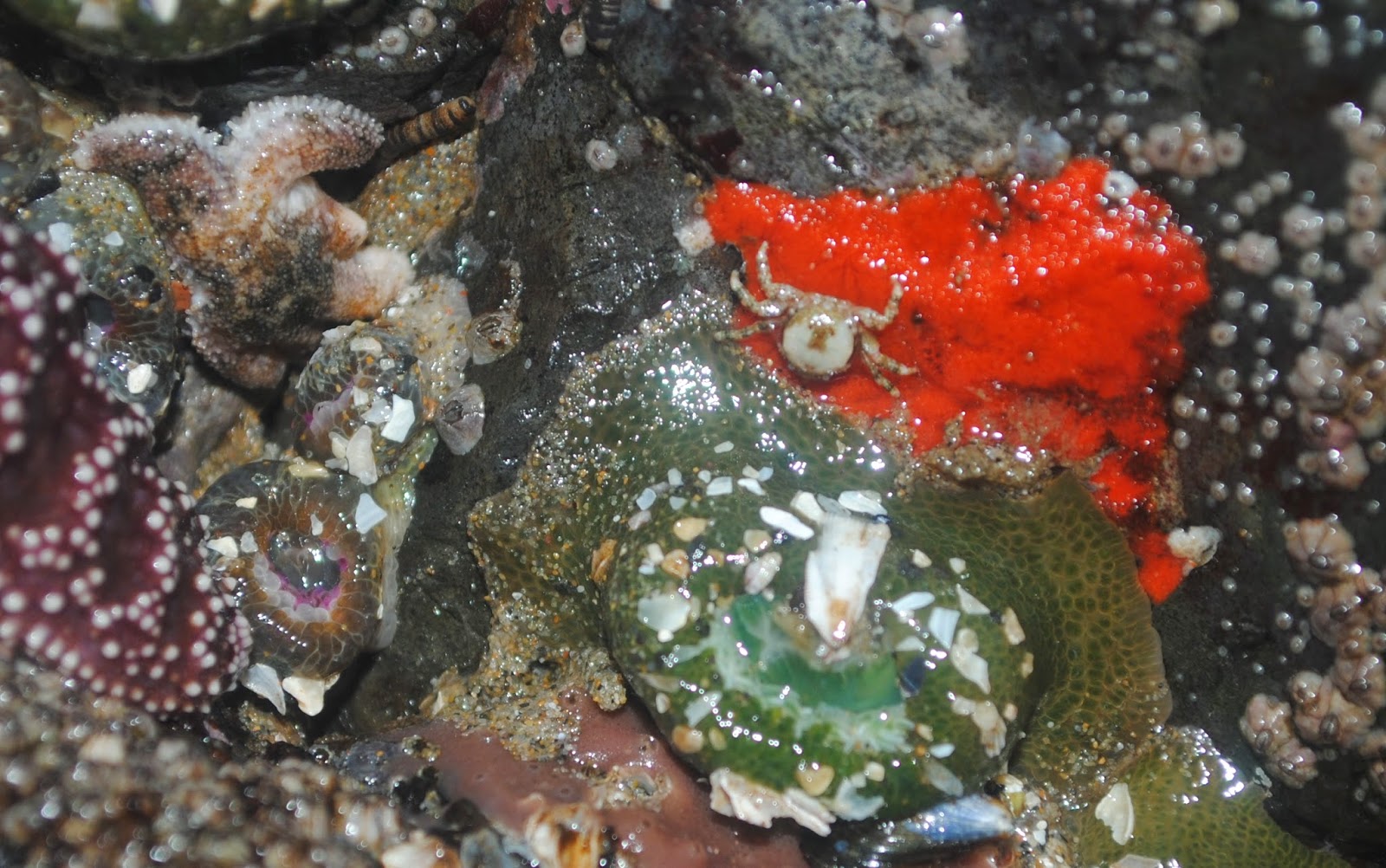July 7th - July 13th 2014
Daily Low Tides
Monday, July 7th
Low Tide: 2.6' @ 2:21 PM
Tuesday, July 8th
Low Tide: 2.7' @ 3:25 PM
Wednesday, July 9th
Low Tide: 2.7' @ 4:26 PM
Thursday, July 10th
Low Tide: -0.7' @ 5:45 AM
Low Tide: 2.6' @ 5:25 PM
Friday, July 11th
Low Tide: -1.2 @ 6:34 AM
Low Tide: 2.4 @ 6:21 PM
Saturday, July 12th
Low Tide: -1.5 @ 7:21 AM
Low Tide: 2.1 @ 7:15 PM
Sunday, July 13th
Low Tide: -1.6 @ 8:07 AM - Lowest tide of the year!
Low Tide:1.8 @ 8:09 PM
Notes from the week
Great weather and our lowest tides of the year combined to make this an excellent time to explore the tidepools at Haystack Rock. This post is going to mostly be a list and photos of some of the amazing creatures we saw!
Creature Highlights
Birds
Photos from Haystack Rock
Monday, July 7th
Low Tide: 2.6' @ 2:21 PM
Tuesday, July 8th
Low Tide: 2.7' @ 3:25 PM
Wednesday, July 9th
Low Tide: 2.7' @ 4:26 PM
Thursday, July 10th
Low Tide: -0.7' @ 5:45 AM
Low Tide: 2.6' @ 5:25 PM
Friday, July 11th
Low Tide: -1.2 @ 6:34 AM
Low Tide: 2.4 @ 6:21 PM
Saturday, July 12th
Low Tide: -1.5 @ 7:21 AM
Low Tide: 2.1 @ 7:15 PM
Sunday, July 13th
Low Tide: -1.6 @ 8:07 AM - Lowest tide of the year!
Low Tide:1.8 @ 8:09 PM
Notes from the week
Great weather and our lowest tides of the year combined to make this an excellent time to explore the tidepools at Haystack Rock. This post is going to mostly be a list and photos of some of the amazing creatures we saw!
Creature Highlights
Birds
- Black Oystercatchers (Haematopus bachmani)- observed in the saddle area potentially looking to nest again?
- Bald Eagle (Haliaeetus leucocephalis)
- Great Blue Herron (Ardea herodias) - flew over and disturbed nesting birds
- Pigeon Guillemot (Cepphus columba) - observed with chicks, very active and heard calling frequently, spotted returning to their nests with fish
- Tufted Puffin (Fratercula cirrhata) - many observed in the grassy slope on the north and soaring around the rock
- Pelagic Cormorant (Phalacrocorax pelagicus) - observed feeding chicks
Invertebrates
- Leopard Nudibranch (Diaulula sandiegensis)
- Granular Claw Crab (Oedignathus inermis)
- Dungeness Crab (Cancer magister) - male and female spotted
- Leather Chiton (Katharina tunicata)
- Lined Chiton (Tonicella lineata)
- Shaggy Mouse Nudibranch (Aeolid papillosa)
- Sea Lemon Nudibranch (Anisodoris nobilis) - observed feeding on Bread Crumb Sponge
- Purple Sea Urchin (Strongylocentrotus purpurpatus)
- Six-rayed Sea Stars (Leptasterias hexactis)
- Opalescent Nudibranch (Hermissenda crassicornis)
- Mossy Chiton (Mopalia muscosa)
- Olive Snail (Callianax biplicata)
- Red Rock Crab (Cancer productus)- juveniles and adults observed
- Red Nudibranch (Rostanga pulchra)
- Ochre Sea Star (Pisaster ochraceus) - adults and juveniles seen, mostly out at the needles
- Giant Green Anemone (Anthopleura xanthogrammica)
- Aggregating Anemone (Anthopleura elegantissima)
- Bread Crumb Sponge (Halichondria sp.)
- Red Encrusting Sponge (Ophlitaspongia pennata)
- Hairy Chiton (Mopalia ciliata)
- Speckled Limpet (Tectura persona)
- Purple Encrusting Sponge (Haliclona permollis)
Photos from Haystack Rock
A juvenile red rock crab perches on a patch of red encrusting sponge. To the left, a six rayed sea star clings above aggregating anemones. Photo taken by volunteer interpreter Kari Kidd.
A tiny red nudibranch grazes on its food of choice, red encrusting sponge. The small bump just left of the center of the sponge is the nudibranch. Above photo courtesy of volunteer interpreter Kari Kidd. Photo below taken by staff interpreter Susan Glarum.
Above: A red rock crab hides in rock crevice next to a lined chiton and giant green sea anemone. Photo taken by staff interpreter Katie Corliss. Below: Another red rock crab peers out from a crack. Photo by staff interpreter Susan Glarum.
Beautifully colored lined chitons. Photo above courtesy of staff interpreter Katie Corliss, below taken by staff interpreter Susan Glarum.
Six rayed sea star - they do not get much larger than this. Photo by staff interpreter Katie Corliss.
A shield limpet hitches a ride from a mossy chiton. Photo courtesy of staff interpreter Katie Corliss.
Hariy hermit crab. Photo by staff interpreter Susan Glarum.
Pelagic cormorant and chick. Photo courtesy of staff interpreter Susan Glarum.
Purple encrusting sponge and aggregating anemones. Photo by staff interpreter Katie Corliss.
Albino leather chiton - a rare find! Photo from staff interpreter Nadine Nordquist.
A sea lemon nudibranch chows down on a patch of bread crumb sponge. Photo taken by staff interpreter Susan Glarum.
Distinction between different colonies of aggregating anemones. Each colony is made up of genetically identical animals. Photo taken by staff interpreter Katie Corliss.
A purple sea urchin observed clinging to the underside of a large boulder. Photo taken by volunteer interpreter Kari Kidd.
A pelagic cormorant with its chick. Photo by staff interpreter Susan Glarum.
Tiny hermit crab balancing act. The larger crab is using a barnacle shell for its home! Photo by staff interpreter Katie Corliss.



.JPG)



.JPG)
.JPG)

.JPG)


.JPG)






Comments
Post a Comment